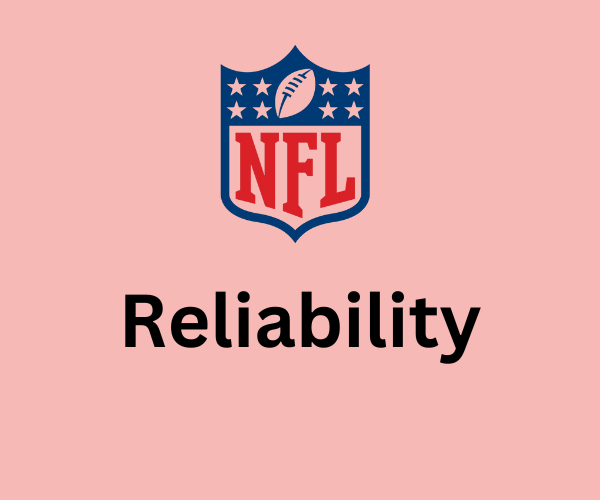
NFL.com is the official website of the National Football League, they publish articles covering topics surrounding the league and football. While most of the stories released by the site are not related to politics, there are certain instances where the topics coincide. Accordingly, we must analyze whether or not there are any bias and reliability issues within those articles. Additionally, their massive viewership base, where according to Similar Web they receive over 45 million visitors per month on their website, necessitates analysis of their bias and reliability.

Source: Pew Research
According to this Pew Research study, most Americans believe that most journalists can separate their views from their reporting. Considering the fact that most reporters who work for NFL.com likely do not often report on political issues, it is important to understand whether or not they can separate their personal views of politics in the rare instances when the topics intersect. The use of sources is a common culprit in introducing bias within reporting, we will seek to understand within this article if NFL.com is trustworthy and properly uses evidence in their articles.
Does Reliability Matter?
Reliability, in general, refers to how trustworthy or accurate information, or in this case, a news source is. If we consider this definition, it quickly becomes clear why reliability is important in media sources. If we can’t trust the things we read then there isn’t much of a point in continuing to consume content from that source, after all. So how exactly can we gauge the reliability of a news source anyways?
There are several potential measures of reliability to look out for when trying to determine whether a media source is reliable or not. Red flags for an unreliable article can include the presence of wild unsubstantiated claims, facts dependent on other unreliable sources, heavy use of opinionated language, and more. Some indicators of a reliable news source, on the other hand, include things like:
- Absence of subjective/opinionated language in articles
- Credible sources cited (e.g., neutral sources, .gov, .edu websites)
- Facts and statistics backed by multiple relevant outside sources
- Use of primary sources when possible (e.g., interviews, quotes)
- Information that remains consistent across news sources
How Does NFL.com Fare in its Reliability?
The political reliability index developed by Biasly objectively assesses news organizations’ accuracy and trustworthiness. NFL’s overall Reliability Score has been rated as ‘Fair’ by Biasly.
NFL’s Source Analysis Score is ‘Fair,’ which suggests readers can trust some of the sources, links, and quotes provided by the news source. This score, which is based on A.I., focuses on assessing the quality of sources and quotes used including their number, lengths, uniqueness, and diversity.
However, since these scores are based on percentages and averages, individual articles could be more or less trustworthy depending on the context, author, and other factors. Later, we will analyze individual articles and see how some of these components can affect reliability.
Let us analyze the supporting data for the NFL’s rankings and discuss what to watch out for while searching for trustworthy news sources.
NFL.com Accuracy and Reliability
A news source’s level of reliability can often be impacted by bias in addition to a variety of other factors. However, in almost every case for a publication their reliability is paramount in the perception they receive from their readership base. Considering the popularity of the NFL it is important to understand whether they are trustworthy or undependable.
It is important to understand when analyzing the overall ratings provided by Biasly, which is an aggregate of many articles, individual articles published by the source may vary in their bias and reliability ratings. For example, just as Biasly rated the NFL as Fair in terms of Overall Reliability, American Thinker was also rated as Fair for Overall Reliability. In terms of individual articles, the ratings vary, where one article, “Voter Roll Cleanup Shows that the 2020 Election Was Anything but the Most Secure in History”, was rated as Good in Reliability. On the other hand, the article “Race in the Race” was rated as Fair for Reliability. These articles with differentiating ratings show that a news source may not always be consistent in its reliability. Multiple factors can affect the bias and reliability of a publication, we will delve deeper into these in further sections.
Quality of Sources and Facts Used
The NFL, as discussed in the introductory section, does not typically report on political issues, however, there are certain points at which athletic-related and politically-related subjects collide. One example of this is exhibited in the article “Congress Asks Roger Goodell, Dan Snyder to Appear at Hearing on Washington Franchise Workplace Culture”. Through the use of their AI algorithms, Biasly rated this article as being Somewhat Conservative in terms of Bias and Fair for Reliability.
To understand what led to the reliability rating of this article we must take a few factors into account, first is the quality of sources and facts used. This article used 8 total quotations, of these quotations the author used 3 long quotes, 2 medium quotes, and 3 short quotations with three or fewer words.
Considering the length of the article, the total number of quotes used is acceptable, the author used an adequate amount of quotations as evidence for the claims that they made. Additionally, the ratio of long quotes to short and medium quotes is also decent. It is generally better to have a higher number of longer quotes in comparison to shorter quotes, this is because it is more difficult for an author to take a source’s words out of context when a longer quotation is used. On the contrary, when a shorter quote is used it makes it far easier for the author to use a source’s words in a manner that was not intended.
The author of this article used 6 sources:
- Carolyn B. Maloney (Liberal-leaning)
- Raja Krishnamoorthi (Liberal-leaning)
- Brian McCarthy (NFL Spokesperson, Center-right)
- Tom Pelissero (NFL Network, Center-right)
- NFL (Center-right)
- Washington Commanders Press Release
Again, considering the length of the article the number of sources used throughout to corroborate the claims made with evidence is acceptable. A lack of trustworthy sources to provide evidence throughout the article can negatively affect the reliability of the story since the difficulty of checking if the claims the author made are true increases. Additionally, the dispersion of sources in terms of sides is also ideal, when there are sources used on both sides of a situation it offers the reader a far more balanced perspective on the situation.
Selection and Omission Bias
Selection bias is when stories and facts are selected or deselected, often on ideological grounds, to create a narrative in support of the new sources’ ideology. Omission bias, on the other hand, is when different opinions and political views regarding a situation are left out so that the reader is only exposed to the ideological perspective supported by the author. It’s important to keep in mind these two types of biases when trying to assess an article’s level of accuracy.
One article that exemplifies the use of selection and omission by the NFL is “Video Shows Officers Dragged WR Tyreek Hill Out of Car After He Put Window Back Up; Dolphins Release Statement”. Within this article, the author described the events that occurred and subsequent responses from the parties:
“Hill, 30, who is Black, said he wondered what would have happened to him if he weren’t an NFL star. Some of his teammates who are also Black said they were used to seeing that sort of interaction.”
“Dolphins coach Mike McDaniel said Monday he was upset by the situation. McDaniel appeared to fight back tears as he reflected on the incident.”
The author used 3 sources in the article to describe the situation from the Miami-Dade Police’s perspective, while the author used 6 sources to describe the situation from Tyreek Hill’s perspective, in addition to that of the Miami Dolphins Football Team. This disparity of sources used in the article led to an overemphasis in descriptions that are sympathetic towards Hill. Although this article is not an overt case of complete omission regarding the event that occurred, there is still a lack of emphasis on the police’s perspective. Using sources in such a manner may sway the reader to agree with the statements made by Hill, his teammates, and the team.
Looking into the article discussed in the previous section, “Congress Asks Roger Goodell, Dan Snyder to Appear at Hearing on Washington Franchise Workplace Culture”. This article does not fall under the same issues as the former in this section, this is because the author used 3 sources on the side of the NFL, 2 sources on the side of the US government, and 1 source representing the Washington Commanders. This ratio of sources provides a relatively equal balance in perspective of the situation, as a result, the reader will not be as likely to be swayed to a certain side solely due to the author’s portrayal of the situation through their use of sources.
So is the NFL Reliable?
Considering that the NFL received a Reliability Score of Fair, it can be assumed that the publication is somewhat trustworthy in its analysis of political issues. It must be emphasized again, however, that the NFL does not regularly report on political issues, and when it does the ratings of individual articles may vary from their overall score. Remaining aware of bias and reliability issues is helpful regardless, for more insight into bias and reliability in news articles Biasly’s News Check can provide valuable information.






















